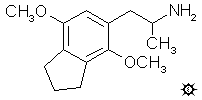
#82 G-3
2,5-DIMETHOXY-3,4-(TRIMETHYLENE)AMPHETAMINE; 5-(2-AMINOPROPYL)-4,7-DIMETHOXYINDANE
|
| [3D .mol structure] |
Fifty milliliters of 1 M LAH in THF was placed in an inert atmosphere, well stirred, and cooled to 0 °C with an external ice-bath. There was added, dropwise, 1.35 mL of 100% H2SO4 at a rate slow enough to minimize charring. There was then added, dropwise, 2.8 g 1-(2,5-dimethoxy-3,4-(trimethylene)phenyl)-2-nitropropene in 15 mL THF. At the end of the addition, the stirring was continued for an additional 0.5 h, and then the reaction mixture was held at reflux on the steam bath for another 0.5 h. After cooling again to ice-bath temperature, the excess hydride was destroyed with the addition of 11 mL IPA, followed by 5.5 mL 5% NaOH which converted the inorganic mass through a cottage cheese stage into a loose, filterable texture. The solids were removed by filtration, washed with additional THF, and the combined filtrates and washes stripped of solvent under vacuum. There was obtained 2.51 g of a white oil that was distilled at 115-135 °C at 0.2 mm/Hg to give 1.83 g of a clear colorless oil. This was dissolved in 8 mL IPA, neutralized with 28 drops of concentrated HCl, and diluted with 140 mL anhydrous Et2O. In about 0.5 h there started a slow snowfall of fine fluffy white crystals which was allowed to continue until no additional crystals appeared. After filtering, Et2O washing and air drying, there was obtained 1.81 g of 2,5-dimethoxy-3,4-(trimethylene)amphetamine hydrochloride (G-3) with a mp of 157-159 °C. Anal. (C14H22ClNO2) C,H.
DOSAGE: 12 - 18 mg.
DURATION: 8 - 12 h.
QUALITATIVE COMMENTS: (with 12 mg) There was a warmth, a mellowness, as things developed. No body disturbance at all, but then there were no visuals either which, for me on this particular occasion, was disappointing. The day was consumed in reading, and I identified completely with the character of my fictional hero. It was a different form of fantasy. I think I prefer music as a structural basis for fantasy.
(with 18 mg) I am at a plus three, but I am not at all sure of why it is a plus three. With my eyes closed, there are puffy clouds, but no drama at all. Music was not exciting. There could well have been easy eroticism, but there was no push in that direction. No great amount of appetite. Not much of anything, and still a plus three. Simply lying still and surveying the body rather than the visual scene gave some suggestions of neurological sensitivity, but with getting up and moving about and doing things, all was fine. The next morning I was perhaps moving a bit more slowly than usual. I am not sure that there would be reward in going higher.
EXTENSIONS AND COMMENTARY: In a comparison between the 2-carbon compound (2C-G-3) and the 3-carbon compound (G-3) the vote goes towards the phenethylamine (the 2-carbon compound). With the first member of this series (2C-G versus GANESHA) this was a stand-off, both as to quantitative effects (potency) and qualitative effects (nature of activity). Here, with the somewhat bulkier group located at the definitive 3,4-positions, the nod is to the shorter chain, for the first time ever. The potency differences are small, and maybe the amphetamine is still a bit more potent. But there are hints of discomfort with this latter compound that seem to be absent with the phenethylamine. The more highly substituted compounds (q.v.) more clearly define these differences.
| [ |
[Main Index] | [Forward |

